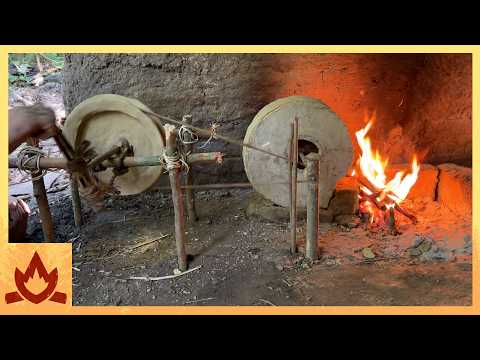Primitive Technology: Belt and pulley blower

At tiled hut The old forge blower is broken from 4 years of use. Clay is dug to make a new housing. Old broken roof tiles are crushed to make grog for the clay. Grog is mixed with clay to stop it from cracking as it dries. The ground is dusted with ash to stop the clay sticking to it.
Clay is flattened into a disk A 25 cm diameter circle is scribed into the clay. The outlet of the housing will be 5 cm wide so a mark is made 2 knuckles from the edge. String is made by twisting 2 bark fibre strands clockwise separately and then anticlockwise back together.
My method to scribe a volute shape for the blower starts by placing the end of the string on the outlet mark and the other end on the centre of the blower housing. Next, a clay cylinder approximately 1/3rd the width of the outlet is place in the centre on top of the string, holding it in place. The string is then wrapped around the cylinder. It should go from the outlet mark to the edge of the circle perfectly with one revolution. If not, change the width of the cylinder. The string is then unwound and scribes an approximate volute shape.
The shape of the spout then continues straight out from the outlet. Coils of clay are added to from the walls of the housing. Excess clay is cut from the base outside the walls of the housing. A central hole about 5 cm in diameter is cut into the centre of the housing base.
I'm going to make a wooden bearing to hold the rotor in the centre of the housing. The crude iron knife is used to awl a hole in the wood. The bearing block is then cut from the end of the wood. It will be fixed in place with clay when the housing is dry.
Fire by friction. The housing is dried by the fire. Now for the lid. Clay is made into a disc on the ground and the housing placed on top.
Excess clay is trimmed from the lid. The approximate centre is marked with a stick. A 10 cm hole is cut centred on the mark. The wooden bearing is held in place with clay. The fan spokes are tested for clearance of the housing walls. Here I'm making a clay bat, which is just a flat surface to make clay objects on that can be moved about while drying.
This is a clay tuyere, a tube to convey air from the blower to the fire in a concentrated jet. Here I'm positioning the blower housing next to the fireplace. A base of wet clay is place here for the housing to sit in. Clay at the back to prevent it from falling sideways.
Determining position of rotor support stake. Digging hole with another stake so as not to split the hole in the other stake. Light taps so as not to break the good stake. Installing fan rotor in housing and stake bearings. The old rope stick drive mechanism and technique. Lid on.
Installing tuyere into outlet with clay. Sealing lid with clay. Leaves crushed to provide fibre for clay. Clay mixed with fibre. This will form the parts that need tensile strength.
A small pulley wheel is made on the rotor. A groove for the string is pressed into it. The rotor is then taken off to dry so it wont shrink and break on the wood. A large pulley wheel is now made on the pottery bat from before. A rim is made around the edge to hold the rope. A hole and support hub is made in the centre to go over a wooden rotor. The crude wheel will be the starting point of my experiments.
A bark fibre rope belt is made by attaching the ends. It is tied with a knot here but splicing is a better method. When used directly on the rotor, the rope slides resulting in no rotation. When used on the wheel however, the rope bites in and transfers energy, spinning the fan. The wheel broke yesterday so it is replaced with a spare. Making a frame to hold the drive wheel. The wheel will sit on rails so that the position of the drive wheel can be changed to get the right tension in the belt.
The wheel and rotor sit on the rails and the belt is wrapped around it. Rope stoppers hold the rotor roughly in place. When turned, the wheel rolls away from the fan rotor so that tension is automatically applied dynamically as opposed to statically.
A crank is applied to the rotor to turn it by hand. The heavy clay wheel slides on the rotor, so a hole is drilled into it to fix it via a rope. This time the belt came off due to sideways wobble. A sliver of cane is wedged into the rotor hole to help stabilize it. The uneven diameter of the wheel and it's mass cause issues with smooth operation. The hub broke off and so I'll attempt a wheel from different material. I'll make a wheel from cane, woven into a cylinder so it forms the cross section of a basket.
17 ribs of the basket are hammered into the ground in the shape of a circle 25 cm in diameter. Cane is then woven between the uprights using the standard weaving technique. The basket is pulled off the ground when done.
Half of the cane is removed and the ribs are bent outwards. The cane is then woven back on to create a flanged shape. The same is done to the other side. The wheel rim now has a waist for the string to sit in. The basket wheel is then attached to the rotor via two spokes.
The wheel is then tied loosely to the rails of the frame. Uneven diameter causes the tightening and loosening of the belt but it's better than before. I'll remove the inner run of cane and see if that will act as a groove for the string. The new set up seems to work better than the clay wheel, as it can be turned faster.
One rotation of the large wheel gives about 10 rotations of the fan. The small wheel broke and the string caught on the spoke of the large wheel. Making new small wheels with a flanged design for better guidance. A key way is also added to fix it to the rotor.
Small wheel fixed to rotor with wooden key. To simplify the system, I'll make a "floating" wheel that needs no frame to hold it. 2 longer ribs will act as handles for the new wheel. The belt is wrapped around the wheels and is twisted so that the rotor spins in the opposite direction to the drive wheel. Both handles are held in the opposite hand and the wheel is turned about an imaginary axle.
The new, simpler set up seems to work better as the fire roars more. This is puzzling as the rotations of the large wheel are slightly less now than the previous design. This may be due to the twist in the belt giving better traction than the previous method, causing less slippage. Though the floating wheel is simpler, I don't think it would scale well to a larger wheel which would give a higher RPM. So it might be worth experimenting with the previous fixed frame method. It does however make a simple and possibly superior competitor to the rope stick drive used up to this point in iron smelting.
2025-06-09 11:38


